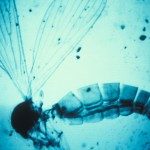Link to Pubmed [PMID] – 21880776
J. Virol. 2011 Nov;85(21):11016-21
RNA interference (RNAi) is the essential component of antiviral immunity in invertebrates and plants. One of the landmarks of the antiviral RNAi response is the production of virus-derived small interfering RNA (vsiRNA) from viral double-stranded RNA (dsRNA). vsiRNAs constitute a fragmented image of the viral genome sequence that results from Dicer cleavage. vsiRNA sequence profiling is used extensively as a surrogate to study the antiviral RNAi response by determining the nature of the viral dsRNA molecules exposed to and processed by the RNAi machinery. The accuracy of these profiles depends on the actual viral genome sequence used as a reference to align vsiRNA reads, and the interpretation of inaccurate profiles can be misleading. Using Flock house virus and Drosophila melanogaster as a model RNAi-competent organism, we show accurate reconstruction of full-length virus reference sequence from vsiRNAs and prediction of the structure of defective interfering particles (DIs). We developed a Perl script, named Paparazzi, that reconstitutes viral genomes through an iterative alignment/consensus call procedure using a related reference sequence as scaffold. As prevalent DI-derived reads introduce artifacts during reconstruction, Paparazzi eliminates DI-specific reads to improve the quality of the reconstructed genome. Paparazzi constitutes a promising alternative to Sanger sequencing in this context and an effective tool to study antiviral RNAi mechanisms by accurately quantifying vsiRNA along the replicating viral genome. We further discuss Paparazzi as a companion tool for virus discovery as it provides full-length genome sequences and corrects for potential artifacts of assembly.


